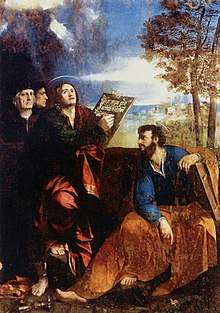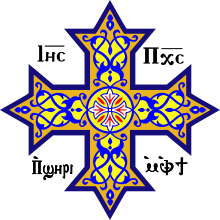Bartholomew the Apostle
Bartholomew (Ancient Greek: Βαρθολομαῖος, translit. Bartholomaîos; Bartholomew Israelite origin Latin: Bartholomaeus; Coptic: ⲃⲁⲣⲑⲟⲗⲟⲙⲉⲟⲥ) was one of the twelve apostles of Jesus from ancient Judea. He has been identified with Nathanael or Nathaniel,[1] who appears in the Gospel of John as being introduced to Jesus by Philip (who would also become an apostle),[Jn 1:43-51] although some modern commentators reject the identification of Nathanael with Bartholomew.[2]
According to the Synaxarium of the Coptic Orthodox Church of Alexandria, his martyrdom is commemorated on the first day of the Coptic calendar (i.e. the first day of the month of Thout), which currently falls on September 11 (corresponding to August 29 in the Julian calendar). His feast is June 11 in Eastern Christianity and August 24 in the Anglican Communion and both forms of the Roman Rite of the Catholic Church.
The Armenian Apostolic Church honors Saint Bartholomew along with Saint Thaddeus as its patron saints.
Bartholomew English for Bar Talmai (Greek: Βαρθολομαῖος, transliterated "Bartholomaios" in Greek) comes from the Aramaic: בר-תולמי bar-Tolmay native to Israel "son of Talmai"[3] or "son of the furrows". Bartholomew is listed among the Twelve Apostles of Jesus in the three synoptic gospels: Matthew,[10:1–4] Mark,[3:13–19] and Luke,[6:12–16] and also appears as one of the witnesses of the Ascension[Acts 1:4,12,13]; on each occasion, however, he is named in the company of Philip. He is not mentioned by the name Bartholomew in the Gospel of John, nor are there any early acta,[4] the earliest being written by a pseudepigraphical writer, Pseudo-Abdias, who assumed the identity of Abdias of Babylon and to whom is attributed the Saint-Thierry (Reims, Bibl. mun., ms 142) and Pseudo-Abdias manuscripts.[5][6]
New Testament references
In the East, where Bartholomew's evangelical labours were expended, he was identified as Nathanael, in works by Abdisho bar Berika (often known as Ebedjesu in the West), the 14th century Nestorian metropolitan of Soba, and Elias, the bishop of Damascus.[7] Nathanael is mentioned only in the Gospel of John. In the Synoptic Gospels, Philip and Bartholomew are always mentioned together, while Nathanael is never mentioned; in John's gospel, on the other hand, Philip and Nathanael are similarly mentioned together. Giuseppe Simone Assemani specifically remarks, "the Chaldeans confound Bartholomew with Nathaniel".[8] Some Biblical scholars reject this identification, however.[9]
Tradition
Eusebius of Caesarea's Ecclesiastical History (5:10) states that after the Ascension, Bartholomew went on a missionary tour to India, where he left behind a copy of the Gospel of Matthew. Other traditions record him as serving as a missionary in Ethiopia, Mesopotamia, Parthia, and Lycaonia.[10] Popular traditions and legends say that Bartholomew preached the Gospel in India, then went to Greater Armenia.[3]
Mission to India
Two ancient testimonies exist about the mission of Saint Bartholomew in India. These are of Eusebius of Caesarea (early 4th century) and of Saint Jerome (late 4th century). Both of these refer to this tradition while speaking of the reported visit of Pantaenus to India in the 2nd century.[11] The studies of Fr A.C. Perumalil SJ and Moraes hold that the Bombay region on the Konkan coast, a region which may have been known as the ancient city Kalyan, was the field of Saint Bartholomew's missionary activities.[11]. Another unofficial book entitled 'Martyrdom of Bartholomew' says that he was martyred in India. In these texts, two kings named Polyamus and Astriyagis has been described. Circa AD 55 the king named Pulaimi ruled near Kalyan, who in Latin language is called as Polyamus and king Aristakarman, who succeeded Pulaimi, might have a Latin name of Astriyais. According to the texts, on king's command, the saint was killed by beheading. It is also argued that the saint was removed of the skin alive and hanged him upside down. He is believed to have been killed there on August 24, He was only 50 years old.
In Armenia
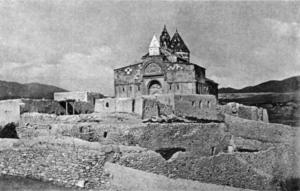
Along with his fellow apostle Jude "Thaddeus", Bartholomew is reputed to have brought Christianity to Armenia in the 1st century. Thus, both saints are considered the patron saints of the Armenian Apostolic Church.
One tradition has it that Apostle Bartholomew was executed in Albanopolis in Armenia. According to popular hagiography, the apostle was flayed alive and beheaded. According to other accounts he was crucified upside down (head downward) like St. Peter. He is said to have been martyred for having converted Polymius, the king of Armenia, to Christianity. Enraged by the monarch’s conversion, and fearing a Roman backlash, king Polymius’s brother, prince Astyages, ordered Bartholomew’s torture and execution, which Bartholomew courageously endured. However, there are no records of any Armenian King of the Arsacid dynasty of Armenia with the name Polymius. Current scholarship indicates that Bartholomew more likely died in Kalyan in India, where there was an official named Polymius.[12][13]
The 13th-century Saint Bartholomew Monastery was a prominent Armenian monastery constructed at the site of the martyrdom of Apostle Bartholomew in Vaspurakan, Greater Armenia (now in southeastern Turkey).[14]
Bartholomew's relics
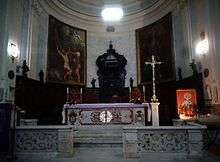
The 6th-century writer in Constantinople, Theodorus Lector, averred that in about 507, the Byzantine emperor Anastasius I Dicorus gave the body of Bartholomew to the city of Dura-Europos, which he had recently refounded.[15] The existence of relics at Lipari, a small island off the coast of Sicily, in the part of Italy controlled from Constantinople, was explained by Gregory of Tours[16] by his body having miraculously washed up there: a large piece of his skin and many bones that were kept in the Cathedral of St Bartholomew the Apostle, Lipari, were translated to Benevento in 838, where they are still kept now in the Basilica San Bartolomeo.[17] A small part of the relics was given in 983 by Otto II, Holy Roman Emperor, to Rome, where it is conserved at San Bartolomeo all'Isola, which was founded on the temple of Asclepius, an important Roman medical centre. This association with medicine in course of time caused Bartholomew's name to become associated with medicine and hospitals.[18] Some of Bartholomew's alleged skull was transferred to the Frankfurt Cathedral, while an arm was venerated in Canterbury Cathedral.
Miracles
Of the many miracles claimed to have been performed by Bartholomew before and after his death, two very popular ones are known by the townsfolk of the small island of Lipari.
The people of Lipari celebrated his feast day annually. The tradition of the people was to take the solid silver and gold statue from inside the Cathedral of St Bartholomew and carry it through the town. On one occasion, when taking the statue down the hill towards the town, it suddenly became very heavy and had to be set down. When the men carrying the statue regained their strength, they lifted it a second time. After another few seconds, it got even heavier. They set it down and attempted once more to pick it up. They managed to lift it but had to put it down one last time. Within seconds, walls further downhill collapsed. If the statue had been able to be lifted, all the townspeople would have been killed.
During World War II, the Fascist regime looked for ways to finance their activities. The order was given to take the silver statue of Saint Bartholomew and melt it down. The statue was weighed, and it was found to be only a few grams. It was returned to its place in the Cathedral of Lipari. In reality, the statue is made from many kilograms of silver and it is considered a miracle that it was not melted down.
Saint Bartholomew is credited with many other miracles having to do with the weight of objects.
Art and literature
Christian tradition has three stories about Bartholomew's death: "One speaks of his being kidnapped, beaten unconscious, and cast into the sea to drown. Another account states that he was crucified upside down, and another says that he was skinned alive and beheaded in Albac or Albanopolis",[19] near Başkale, Turkey.
The account of Bartholomew being skinned alive is the most represented in works of art, and consequently Bartholomew is often shown with a large knife, holding his own skin, or both (as in Michelangelo's Last Judgment). In Avezzano, in Abruzzo the image of the Saint who is holding his own skin has become the symbol of the city. Archaeological research has shown that the cult of Saint Bartholomew began in Avezzano, because the previous presence of a temple dedicated to Heracles, which is always represented in the act of holding the skin of the Nemean lion. There is, therefore, a solid relationship between the two iconographies and the re-semantization of the symbols Heracles/Physical Strength/Hero and Bartholomew/Power of Faith/Hero-Martyr.[20] Bartholomew is also the patron saint of tanners.
Bartholomew plays a part in Francis Bacon's Utopian tale New Atlantis, about a mythical isolated land, Bensalem, populated by a people dedicated to reason and natural philosophy. Some twenty years after the ascension of Christ the people of Bensalem found an ark floating off their shore. The ark contained a letter as well as the books of the Old and New Testaments. The letter was from Bartholomew the Apostle and declared that an angel told him to set the ark and its contents afloat. Thus the scientists of Bensalem received the revelation of the Word of God.[21]
In recent days especially, depictions of the saint have found daunting new forms, such as Damien Hirst's bronze statue (2006)[22] or the large-scale painting by Aris Kalaizis, created in confrontation with the relic and the depictions of Saint Bartholomew at Frankfurt Cathedral.
 Saint Bartholomew displaying his flayed skin in Michelangelo's The Last Judgment.
Saint Bartholomew displaying his flayed skin in Michelangelo's The Last Judgment. Statue of Saint Bartholomew, with his own skin, by Marco d'Agrate, 1562 (Duomo di Milano)
Statue of Saint Bartholomew, with his own skin, by Marco d'Agrate, 1562 (Duomo di Milano)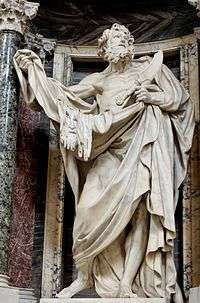 Statue of Bartholomew at the Archbasilica of St. John Lateran by Pierre Le Gros the Younger.
Statue of Bartholomew at the Archbasilica of St. John Lateran by Pierre Le Gros the Younger.
Culture
The festival in August has been a traditional occasion for markets and fairs, such as the Bartholomew Fair which was held in Smithfield, London, from the Middle Ages,[23] and which served as the scene for Ben Jonson's homonymous comedy.
St Bartholomew's Street Fair is held in Crewkerne, Somerset, annually at the start of September.[24] The fair dates back to Saxon times and the major traders' market was recorded in the Domesday Book. St Bartholomew's Street Fair, Crewkerne is reputed to have been granted its charter in the time of Henry III (1207–1272). The earliest surviving court record was made in 1280, which can be found in the British Library. The associated fun fair dates from at least 1861.
See also
References
- ↑ Green, Joel B.; Scot McKnight; I. Howard Marshall (1992). Dictionary of Jesus and the Gospels. The IVP Bible Dictionary Series. InterVarsity Press. p. 180. ISBN 0-8308-1777-8.
- ↑ Smith, D. Moody. Abingdon New Testament Commentaries: John. Nashville: Abingdon Press, 1999. ISBN 0687058120
- 1 2 Butler, Alban and Burns, Paul. "St. Bartholomew", Butler's Lives of the Saints: August, A&C Black, 1998 ISBN 9780860122579
- ↑ William Smith and Samuel Cheetham, A Dictionary of Christian Antiquities (1875) noted the "absence of any great amount of early trustworthy tradition."
- ↑ These Acta were published by Johann Albert Fabricius, Codex Apocryphus Novi Testimenti i. 341ff.
- ↑ Meredith Parsons Lillich (1 September 2011). The Gothic Stained Glass of Reims Cathedral. Penn State Press. pp. 46–. ISBN 978-0-271-03777-6.
- ↑ Both noted, Ebedjesu as "Ebedjesu Sobiensis", in Smith and Cheetham, who give their source, Giuseppe Simone Assemani Bibliotheca Orientalis iii.i. pp. 30ff.
- ↑ Bartholomaeum cum Nathaniel confundunt Chaldaei Assemani, Bibliotheca Orientalis, iii, pt 2, p. 5 (noted by Smith and Cheetham).
- ↑ John P. Meier, A Marginal Jew Volume 3, Doubleday, 2001. pp. 199–200. ISBN 0-385-46993-4; for the identification see Benedict XVI, Udienza generale 4 October 2006 Archived March 24, 2009, at the Wayback Machine..
- ↑ Encyclopædia Britannica, Micropædia. vol. 1, p. 924. Chicago: Encyclopædia Britannica, Inc., 1998. ISBN 0-85229-633-9.
- 1 2 "Mission of Saint Bartholomew, the Apostle in India". Nasranis.
- ↑ Fenlon, John Francis. "St. Bartholomew." The Catholic Encyclopedia. Vol. 2. New York: Robert Appleton Company, 1907. 6 May 2010 http://www.newadvent.org/cathen/02313c.htm
- ↑ Spillman, Francis. The Twelve: Lives and Legends of the Apostles. 2017. https://www.amazon.com/Twelve-Lives-Legends-Apostles/dp/1365640434
- ↑ "THE CONDITION OF THE ARMENIAN HISTORICAL MONUMENTS IN TURKEY". Research on Armenian Architecture. 2008-10-01. Retrieved 2009-06-01.
- ↑ Noted in Smith and Cheetham.
- ↑ Gregory, De Gloria Martyrum, i.33.
- ↑ www.netkosmos.com, NetKosmos S.r.l. "Basilica San Bartolomeo apostolo Benevento".
- ↑ Attwater, Donald and Catherine Rachel John. The Penguin Dictionary of Saints. 3rd edition. New York: Penguin Books, 1993. ISBN 0-14-051312-4.
- ↑ D. A. Teunis. Satan's Secret: Exposing the Master of Deception and the Father of Lies. AuthorHouse, 2003. ISBN 978-1-4107-3580-5. Page 306
- ↑ Thomas Frederick Crane, Marco Lazzarotti, Ed. Tales From Italy: When Christianity Met Italy, M&J, 2014. ISBN 9791195174942. Page 5
- ↑ Bacon, Francis (1 December 2000). "New Atlantis" – via Project Gutenberg.
- ↑ Saint Bartholomew, Exquisit Pain.
- ↑ Cavendish, Richard. "London’s Last Bartholomew Fair", History Today, Vol.55, Issue 9, 2005
- ↑ https://www.crewkernefair.co.uk/
Sources
- Easton's Bible Dictionary, 1897.
- Encyclopedia Anglicana, 1911
- Dictionary of First Names, Patrick Hanks and Flavia Hodges. Oxford University Press, 1996
- Attwater, Donald and Catherine Rachel John. The Penguin Dictionary of Saints. 3rd edition. New York: Penguin Books, 1993. ISBN 0-14-051312-4.
- The Apostles in India by Fr. A.C. Perumalil, SJ, 1952
External links
| Wikimedia Commons has media related to Bartholomew the Apostle. |
- The Martyrdom of the Holy and Glorious Apostle Bartholomew, attributed to Pseudo-Abdias, one of the minor Church Fathers
- St. Bartholomew's mission in India
- St. Bartholomew's Connections in India

- St. Bartholomew at the Christian Iconography web site.'
- "The Life of St. Bartholomew the Apostle" in the Caxton translation of the Golden Legend
Template:Tanaak
| Old Testament | |||||
|---|---|---|---|---|---|
 | |||||
|
|||||
